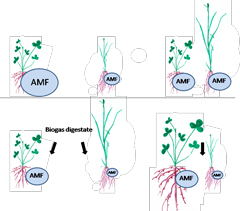Rhizosphere N dynamics and symbiotic activities as influenced by application of biofertilizers
Symbiotic interactions between plant roots and soil microorganisms have profound effects on plant nutrient acquisition. While biogas digestates (biofertilizers) from animal manure, crops or food waste provide a means for nutrient recirculation and promotion of crop productivity, their high nitrogen (N) availability may have less beneficial effects on legume-rhizobia symbiotic activities and N losses. On the other hand, application of biogas digestate to a mixed legume/grass crop may promote soil fertility via complementary nutrient uptake by the co-cultivated species, maintaining high symbiotic activities and low rates of N losses. In this project the legume Medicago sativa (lucerne) was grown alone and in mixture with the grass Dactylis glomerata (cocksfoot), with and without biofertilizer application. The effects of intercropping and fertilization on symbiotic activities were assessed by measurements of plant growth, legume nodulation and abundances of mychorrhiza. Fertilization enhanced aboveground growth of cocksfoot grown alone but it decreased the abundance of arbuscular mycorrhizal fungi (AMF) in cocksfoot (alone and in mixture) as well as in lucerne grown alone. The mycorrhizal symbioses in lucerne and cocksfoot seemed more sensitive to fertilization with biogas digestate than the root nodule symbiosis in lucerne.
Funding: PlantLink
Project leader: Georg Carlsson
Partners: Pål Axel Olsson, Lund University; Stig Edner and Ann Thorén, the Sysav group.
Publications: In preparation
Links
